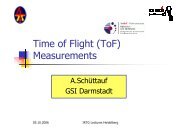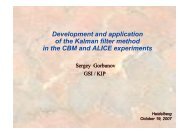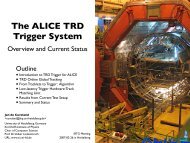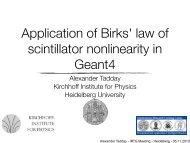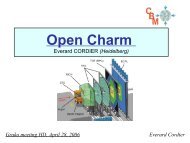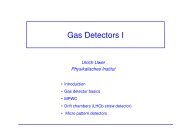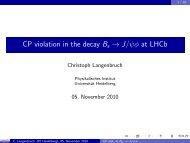Deep Level Transient Spectroscopy ... - IRTG Heidelberg
Deep Level Transient Spectroscopy ... - IRTG Heidelberg
Deep Level Transient Spectroscopy ... - IRTG Heidelberg
Create successful ePaper yourself
Turn your PDF publications into a flip-book with our unique Google optimized e-Paper software.
<strong>Deep</strong> <strong>Level</strong> <strong>Transient</strong><br />
<strong>Spectroscopy</strong>: Characterization<br />
of Radiation Damage<br />
Eduard Monakhov, UiO
Introduction<br />
Electronic levels of main vacancy<br />
related traps in Si:<br />
E c<br />
E c -0.18 eV<br />
E v<br />
VO V 2<br />
-/0<br />
=/-<br />
-/0<br />
0/+<br />
The effect of deep levels<br />
E c -0.23 eV<br />
E c -0.44 eV<br />
E v +0.20 eV<br />
V 2 is important!<br />
Leakage current as a function of the bias in silicon detector with<br />
different types of defects (SILVACO Virtual Wafer Fab).
Introduction<br />
The effect of C and O on radiation hardness of detectors<br />
standart FZ-Si: [O]~10 15 -10 16 cm -3<br />
oxygenated FZ-Si: [O]~10 17 -10 18 cm -3
Introduction<br />
The neutron puzzle<br />
No radiation hardening<br />
for neutron radiation!<br />
.
p +<br />
DLTS technique<br />
a) V=0, t0<br />
p +<br />
W R<br />
e -<br />
n<br />
E f
C<br />
C<br />
=<br />
A<br />
DLTS technique<br />
qε<br />
0ε<br />
( N D − n<br />
2(<br />
V −V<br />
)<br />
bi<br />
T<br />
)<br />
⎛ 1<br />
⎜ −<br />
⎝<br />
qε<br />
0εN<br />
if nT
C<br />
DLTS technique<br />
0<br />
t 1<br />
t 2<br />
t<br />
C(t 2 )-C(t 1 )<br />
T
U 0<br />
U R<br />
C 0<br />
C R<br />
C R0<br />
DLTS technique<br />
filling<br />
pulse<br />
Height and width of<br />
filling pulse can be<br />
varied<br />
t<br />
t
DLTS technique<br />
Typical DLTS spectrum for n-type Si with radiation-induced defects.<br />
VO, 0.18 eV<br />
V 2 (=/-)<br />
0.23 eV<br />
V 2 (-/0)<br />
0.44 eV
C<br />
DLTS technique<br />
e m<br />
e m ’<br />
0 t1 t2 t 3<br />
t<br />
DLTS signal<br />
T<br />
T m<br />
T m ’
DLTS technique<br />
DLTS signal<br />
Spectra for different measurement times (time windows)<br />
0.45<br />
0.40<br />
0.35<br />
0.30<br />
0.25<br />
0.20<br />
0.15<br />
0.10<br />
0.05<br />
0.00<br />
-0.05<br />
100 150 200 250<br />
T, K<br />
In the analysis we determine temperatures of the peaks
DLTS technique<br />
From experiment: (e 1 ,T 1 ); (e 2 ,T 2 ); (e 3 ,T 3 ); …<br />
Expected: e~exp[-(E c -E t )/kT], more precisely: e=N Cσ n v th,n exp[-(Ec-Et)/kT]<br />
e=σ n AT 2 exp[-(Ec-Et)/kT]<br />
ln(e/T 2 )=ln(σ n A)-(Ec-Et)/kT<br />
Plot ln(e/T 2 ) vs 1/T<br />
8h at 200oC 3.5h at 250oC 7.5h at 250o X(0/-):<br />
C<br />
V 2 (0/-):<br />
8h at 200 o C<br />
3.5h at 250 o C<br />
7.5h at 250 o C
DLTS technique<br />
Alternative ways to convert transients to a spectrum<br />
S(T)=∫ C(T,t)w(t)dt<br />
In previous example (box-car):<br />
w(t)=δ(t2)-δ(t1)<br />
Mostly used (’lock-in’ weighting function):
Electron capture cross-section<br />
a) V=V R , t=0<br />
p +<br />
W R<br />
n<br />
p +<br />
b) V=0, 0
Electron capture cross-section<br />
DLTS signal<br />
DLTS signal: S=S max [1-exp(-r n t filing )]<br />
log(time of filling)
Electron capture cross-section<br />
fast capture kinetics slow capture kinetics<br />
a) b)<br />
9.6x10 -15 cm 2<br />
3.1x10 -15 cm 2<br />
E.V. Monakhov, B.S. Avset, A. Hallen, B.G. Svensson, Phys. Rev. B 65, 233207 (2002)<br />
1.3x10 -16 cm 2
Laplace DLTS<br />
The technique is based on solving the following integral equation:<br />
y ( t)<br />
= ∫ F(<br />
λ , t)<br />
s(<br />
λ)<br />
dλ<br />
+ A + ε<br />
If one chooses F(λ,t)=exp(-λt)<br />
the solution s(λ) in case of DLTS is<br />
a sum of delta functions<br />
C<br />
s<br />
t<br />
λ
Laplace DLTS<br />
BioRad<br />
Boonton bridge<br />
capacitance meter<br />
Analog<br />
output<br />
National<br />
Instruments<br />
analog-digital<br />
converter<br />
(PCI card, 12-bit<br />
resolution, 5 MHz<br />
sampling rate)<br />
Laplace-DLTS setup<br />
SemiLab bath type cryostat<br />
with a silicon diode<br />
temperature sensor<br />
Digitized transient<br />
(normally ~10 6 points)<br />
* S. W. Provencher, Computer Physics Communications, 27 (1982) 213<br />
averaging to<br />
10 3 points<br />
LakeShore<br />
temperature<br />
controller<br />
(temperature<br />
stability ~0.02 K)<br />
<strong>Transient</strong> analysis<br />
(program CONTIN*)
DLTS technique<br />
Typical DLTS spectrum for n-type Si with radiation-induced defects.<br />
VO, 0.18 eV<br />
V 2 (=/-)<br />
0.23 eV<br />
V 2 (-/0)<br />
0.44 eV
Interaction of V 2 with defects and impurities<br />
X<br />
V 2<br />
15min at 220 o C<br />
15min at 300 o C<br />
1h at 300 o C<br />
15at 325 o C<br />
E.V. Monakhov, B.S. Avset, A. Hallen, B.G. Svensson, Phys. Rev. B 65, 233207 (2002)<br />
V 2<br />
X<br />
Tentative<br />
identification of X:<br />
X=V 2 O<br />
V 2 +OV 2 O
DLTS signal<br />
0.45<br />
0.40<br />
0.35<br />
0.30<br />
0.25<br />
0.20<br />
0.15<br />
0.10<br />
0.05<br />
0.00<br />
-0.05<br />
Laplace DLTS<br />
Typical Laplace-DLTS spectrum for the overlapping V 2 and X peaks.<br />
100 150 200 250<br />
T, K<br />
V 2 (-/=)<br />
X(-/=)<br />
6 8 10 20 40
Laplace DLTS<br />
DLTS signal (pF)<br />
0.1<br />
Transformation of V 2 to X at 250 o C.<br />
sample A sample C<br />
V 2 (=/-) V 2 (=/-)<br />
X(=/-) X(=/-)<br />
0 1000 2000 3000 4000 5000 6000<br />
Annealing time (min)<br />
A: [O]~(2-3)x10 17 cm -3<br />
C: [O]~(1-2)x10 16 cm -3<br />
Transformation rate<br />
is proportional to [O].<br />
Proves that<br />
X=V 2 O<br />
V 2 +OV 2 O
U 0<br />
U R<br />
Minority carrier DLTS (MCTS)<br />
filling<br />
pulse<br />
if U 0 >0?<br />
Injection of holes to n-type region will occur<br />
Height and width of<br />
filling pulse can be<br />
varied<br />
t
p +<br />
Minority carrier DLTS (MCTS)<br />
a) V=0, t0, t~0<br />
+ p n<br />
0<br />
t<br />
c) V=V R , t>0<br />
p +<br />
h<br />
W R<br />
h<br />
h<br />
e<br />
n<br />
E f
Minority carrier DLTS (MCTS)<br />
VO<br />
V 2 (=)<br />
V 2 (-)<br />
C i O i
SUMMARY<br />
DLTS is a powerful technique for studies of radiation induced defects<br />
Capabilities:<br />
- position of defect levels in the band gap<br />
- concentration of specific defects<br />
- capture cross-sections<br />
- depth distribution<br />
Limitations:<br />
- problems with accurate measurements on minority carriers<br />
- concentration of the defects should be



